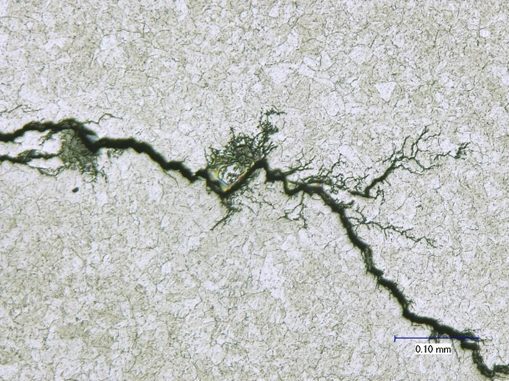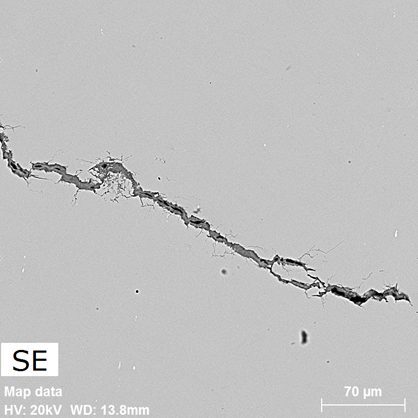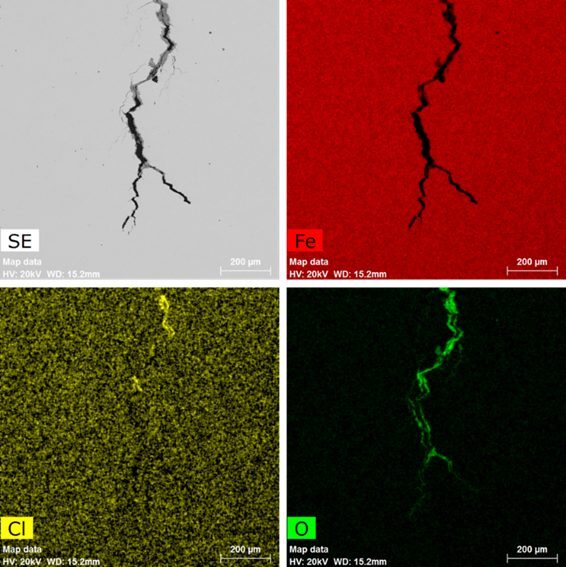RJ Lee Group 7 min read
Stress Corrosion Cracking
Contributors
RJ Lee Group
Subscribe to our newsletter
What Is Stress Corrosion Cracking?
Stress corrosion cracking (SCC) is an environmentally-driven failure mechanism that can be found in metal alloys of all types including pure metals, though pure copper is thought to be immune to SCC. Ceramics and polymers also exhibit forms of environmentally induced crack propagation; however, the focus of the present discussion is on metals. SCC involves the initiation and growth of cracks at stress levels below the yield strength of the material and is typically considered to be a delayed failure process because of the slow crack propagation rate frequently observed. SCC is frequently observed to cause brittle behavior in otherwise ductile materials and can exhibit intergranular, transgranular, or mixed modes of crack propagation. While SCC is a complex process, there are three conditions that must be met for SCC to be active:
- tensile stresses must be present,
- the operating environment must be corrosive,
- the material must be susceptible to that corrosive environment.
Stress Corrosion Cracking Determination
As with most failure mechanisms, stress corrosion cracking is determined by the degree of stress and the severity of the operating environment (temperature and chemistry). The critical tensile stress threshold is specific to the combination of material and corrosive environment and can vary widely; some reports as low as 10% of the yield strength can be found in the literature. It should be noted that not all environments corrosive to a specific material will cause SCC. Further, it is not necessary for the tensile stresses to be imposed on the material during operation. Residual stresses from manufacturing or assembly processes like welding have been observed, in some applications, to be sufficiently high to contribute to SCC failures.
Identification of SCC can be obvious to the trained failure analyst though some situations are more subtle; complex operating conditions or post-fracture damage can make a stress corrosion cracking diagnosis difficult. One of the hallmarks of SCC is the branched crack pattern – reminiscent of a lightning bolt – commonly observed in a metallographically prepared cross-section. However, crack branching is not an absolute requirement as SCC has been observed to follow grain boundaries, which can be more susceptible to corrosion attack and/or mechanically weaker than the bulk material.
Technology & Analysis
As with many corrosion-related failures, examination of the composition along the crack surface can be useful in mechanism identification and corroding species. This must also be approached with caution as the compositional distribution of the corrosion scale is rarely uniform, and the concentration of corroding species necessary for SCC may be very small and below the detection limit of many analytical methods. The use of multiple analytical tools, including wet chemical analysis and microscopic methods, are usually recommended to accurately evaluate SCC behavior during a root cause failure analysis. Since avoiding SCC in the future will require a change in material, a change in the manufacturing process, a change in the operating environment, or some combination thereof, correct diagnosis of SCC and identification of the features that exceeded criticality are essential.
Applicable ASTM standards include Metals and Alloys (G36), Aluminum alloys (G139, G103, G47, G64), Stainless steel (C692, G123, G35), Nickel Alloys (G35), Titanium alloys (F945), Copper alloys (G37, G186, B858), Welds (G58).
1 Sequeira, C.A. 2011. Copper and Copper Alloys. In: Revie, R.W., editor. Uhlig’s Corrosion Handbook. 3rd ed. Hoboken (NJ): John Wiley & Sons. p.757-786.
2 Warke, W.R. 2002. Stress-Corrosion Cracking. In: Becker, W.T. and Shipley, R.J., editors. ASM Handbook: Volume 11 Failure Analysis and Prevention. Materials Park (OH): ASM International. p. 823-860.
This summary description is offered for educational purposes only and no warranty (express or implied) is given on the applicability of this information to any particular part, material, application, or product. This article is not intended to be a complete dissertation on this topic and the reader is encouraged to contact RJ Lee Group for consultation regarding individual applications, materials, or situations.
 Branched crack with a “lightning bolt” appearance.
Branched crack with a “lightning bolt” appearance. Intergranular SCC with limited branching
Intergranular SCC with limited branching EDS maps showing compositional differences observed along the crack length.
EDS maps showing compositional differences observed along the crack length.

